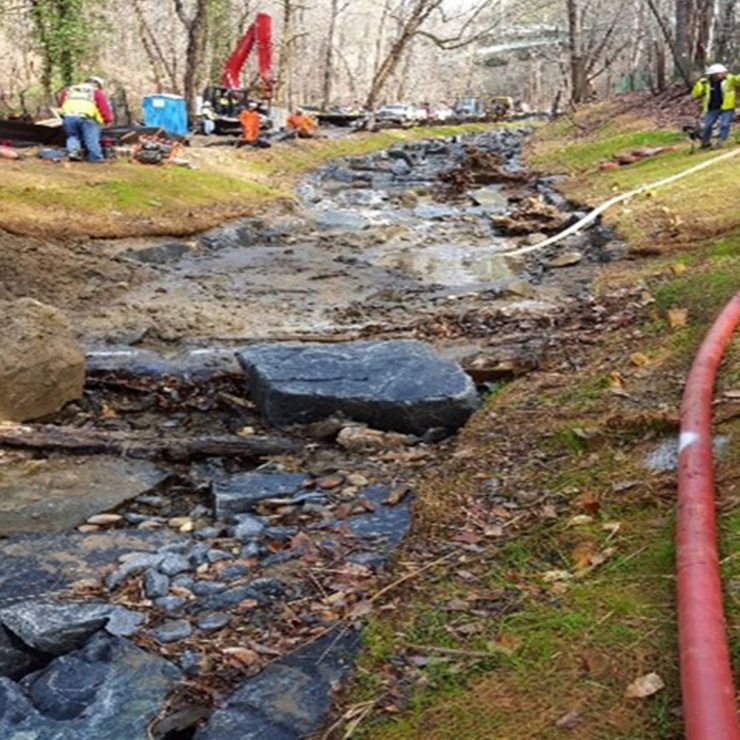By Ricardo Gonzalez, Environmental Construction Manager
The discipline of stream restoration is a blend of engineering, science, and art. It is an undertaking that shapes and places stable features within a dynamic system. As such, it’s not surprising that the success of these environmental restoration projects can be difficult to guarantee. Considering the investment of time, funding, and resources at risk, it is safe to say that stakeholders will want to find cost effective ways to improve the outcome of their project. However, one important aspect of the restoration process is often overlooked – construction inspection. Construction inspection is an integral component of stream restoration that provides assurance that the scientist’s vision and engineer’s designs can be effectively implemented in the field by the contractor. The omission of construction inspection may be due to the fear of excessive cost, the belief that the plans should convey the design and project intent sufficiently, the thought that the contractor should know what they are doing, and/or the confidence that intermittent site visits by the Owner will be sufficient for successful implementation. The truth is that having dedicated experienced construction inspection staff on site can save money and ensure that the Owner’s project is being properly implemented.
With initiatives like Watershed Implementation Plans for the Chesapeake Bay TMDL and the NPDES MS4 Program, we are seeing a greater use of stream restoration as part of an overall watershed strategy to meet nutrient and sediment load reduction targets. Stream restoration has been shown to provide more sediment reduction for the money than traditional storm water management approaches. Proper implementation of stream restoration projects, verified through monitoring, will significantly increase load reduction credits received for stream restoration. Maximizing credits for each project can provide savings to the stakeholder by reducing the number of projects needed to meet pollutant reduction goals. The construction inspector provides verification to the stakeholder that their projects are being constructed properly and offers the best chance to maximize credits.
Occasionally, adjustments to design plans are necessary in order for the project to meet the functional intent of the design. Differing site conditions, unsuitable materials and unforeseen utility conflicts all present challenges that the designer or contractor may not have anticipated and may not be ready to address in a timely fashion. The dedicated construction inspector who is on site during crucial phases of construction can quickly identify and help resolve conflicts and keep the project on schedule and functioning as intended. Furthermore, the experienced construction inspector may be able to propose opportunities for project enhancement, improving the value and function of the project.
The construction inspector serves as the client’s eyes and ears, with the client’s interest first and foremost. They can provide a wide range of services from basic to full service. Depending on the project Owner’s needs and their staffing capabilities and availability, the construction management team can help relieve as much or as little of the day-to-day responsibilities of construction operations as the client needs. The construction inspector may just be needed to provide expertise about proper installation of specialized structures and may be scheduled to only be on site to verify their proper installation. Critical elements of some structures are invisible after installation (e.g., footers, key-ins), but their presence is crucial to the structure’s stability and function. Structures built incorrectly will be prone to failure. So the knowledge that systems are installed correctly should prove valuable to a client.
Construction inspection services are not limited to only providing benefits to project Owners. With the proliferation of environmental construction opportunities (e.g., stormwater program compliance, mitigation requirements, etc.), more and more contractors from other areas of construction are being attracted to ecological restoration. Many of these contractors lack the experience and expertise required to implement these types of projects efficiently. Employing an experienced environmental construction consultant can provide a helping hand to get a new contractor up to speed quickly. Many environmental construction projects stipulate that the contractor provide a trained specialist to ensure that construction meets the intended function. Personnel with this type of specialized training are hard to find. Temporarily contracting these services for the duration of a contract may be an approach for a contractor to meet the contract requirements while getting their staff trained for future contracts.
